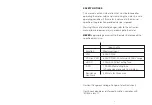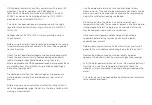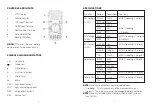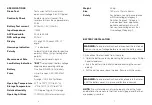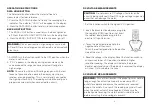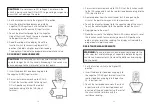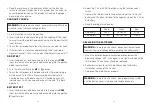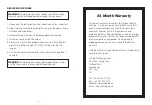
4. Read the resistance in the display and then set the function
switch to the lowest W position that is greater than the actual or
any anticipated resistance. The display will indicate the proper
decimal point and value.
CONTINUITY CHECK
1. Set the function switch to the position.
2. Insert the black lead banana plug into the negative (COM) input
terminal Insert the red test lead banana plug into the positive (Ω)
input terminal.
3. Touch the test probe tips to the circuit or wire you wish to check.
4. If the resistance is less than approximately 30Ω, the audible
signal will sound. If the circuit is open, the display will indicate “1”.
DIODE TEST
1. Insert the black test lead banana plug into the negative
COM
input terminal and the red test lead banana plug into the positive
diode input terminal.
2. Turn the rotary switch to the
/ •)))
position.
3. Touch the test probes to the diode under test. Forward voltage
will indicate 400 to 700mV. Reverse voltage will indicate “
I
”.
Shorted devices will indicate near 0mV. Shorted devices will
indicate near 0mV and an open device will indicate “
I
” in both
polarities.
BATTERY TEST
1. Insert the black test lead banana plug into the negative
COM
input terminal and the red test lead banana plug into the positive
V
input terminal.
WARNING:
To avoid electric shock, never measure continuity on
circuits or wires that have voltage on them.
WARNING:
To avoid electric shock, disconnect the test leads
from any source of voltage before removing the battery cover.
WARNING:
To avoid electric shock, do not operate your meter
until the battery cover is in place and fastened securely.
2. Select the 1.5V or 9V BAT position using the function select
switch.
3. Connect the red test lead to the positive side of the 1.5V or 9V
battery and the black test lead to the negative side of the 1.5V or
9V battery.
4. Read the voltage in the display.
REPLACING THE BATTERIES
1. When the batteries become exhausted or drop below the
operating voltage, “BAT” will appear in the right-hand side of the
LCD display. The batteries should be replaced.
2. Follow instructions for installing batteries. See the Battery
Installation section of this manual.
3. Dispose of the old batteries properly.
Good
Weak
Bad
9V battery:
>8.2V
7.2 to 8.2V
<7.2V
1.5V battery:
>1.35V
1.22 to 1.35V
<1.22V
12
13


